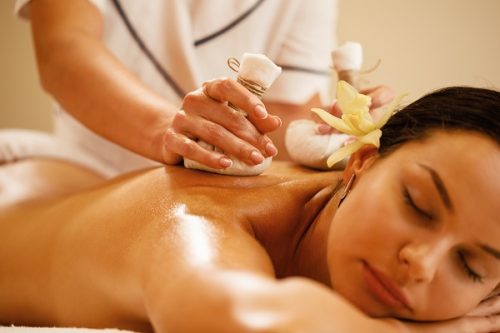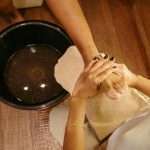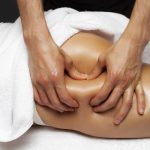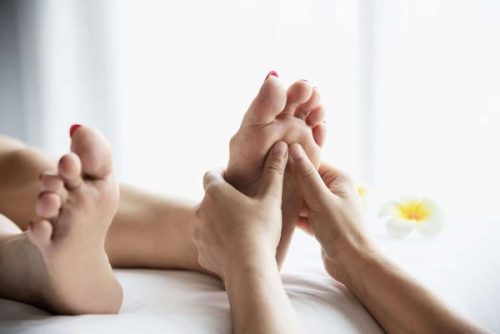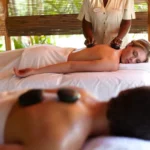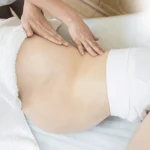Traditional Thai massage, also known as Nuad Thai, is an ancient healing practice that blends acupressure, assisted yoga postures, and energy work. Unlike traditional Western massages that involve oils and passive relaxation on a table, this traditional Thai technique is performed fully clothed on a padded mat, with dynamic movements that stretch, compress, and mobilize the entire body. In this guide, we’ll explore what traditional Thai massage is, how it differs from other massage styles, the techniques used, and the many benefits of this full-body experience.

Table of Contents
The Origins of Traditional Thai Massage: A 2,500-Year Tradition
Traditional Thai massage traces its roots back more than 2,500 years to India, where it was shaped by the principles of Ayurveda and introduced to Thailand by Buddhist monks. It evolved within temple settings as both a spiritual and therapeutic practice. Central to Thai bodywork is the concept of Sen lines—energy channels believed to run through the body. By manipulating these lines, practitioners aim to balance the body’s internal energy and promote holistic well-being (National Library of Medicine).
In 2019, UNESCO recognized traditional Thai massage as an Intangible Cultural Heritage of Humanity, a testament to its importance and enduring value (UNESCO).
This traditional technique is not just a physical treatment—it’s part of a broader cultural and spiritual framework. In Thailand, it’s often paired with meditation, herbal remedies, and spiritual rituals. Historically, monks and laypeople practiced it as a form of compassionate touch to heal both body and spirit.
Today, this technique is taught in formal schools across Thailand and globally. Modern therapists continue to study its ancient techniques, blending them with anatomy, biomechanics, and client-specific wellness strategies to better serve diverse needs.

How Traditional Thai Massage Differs From Other Styles
One of the key differences between traditional Thai massage and Western massage therapy lies in its philosophy and technique. Here’s how it stands out:
👕 Fully Clothed: Clients remain dressed in loose, comfortable clothing.
🧘♂️ Mat-Based: Performed on a floor mat rather than a massage table.
🦵 Dynamic Movement: Therapists use their hands, elbows, knees, and feet.
🤸 Assisted Stretching: Resembles passive yoga, often called Thai yoga massage.
🔋 Energy Work: Focuses on clearing blockages along Sen lines, similar to meridian-based therapies.
Another key distinction: The massage is traditionally performed in silence or with meditative music, fostering a deep internal focus. It feels more like movement therapy than massage.
Traditional Thai massage also incorporates a rhythmic, almost dance-like flow. Unlike deep tissue or Swedish massage, there is a strong emphasis on sequencing, body positioning, and breath synchronization, creating a meditative treatment experience.
What to Expect During a Full Body Thai Massage Session
A full body Thai massage typically lasts between 60 to 120 minutes. You’ll lie on a firm padded mat while the therapist works your body from feet to head (or vice versa), using a combination of pressure, pulling, rocking, and stretching.
🦶 Feet & Legs: Stimulating Sen lines and releasing tension in the calves and thighs.
🧎♂️ Hips & Lower Back: Deep compression and rotational movements.
💪 Arms & Shoulders: Stretching and joint mobilization.
🧠 Neck & Head: Gentle rocking and cranial holds for relaxation.
Some therapists incorporate Thai herbal compresses or breathing cues to enhance the healing effect. Don’t be surprised if your therapist uses their body weight, climbs onto the mat, or places you in yoga-like poses—this is all part of the traditional Thai bodywork experience.
👣 Want to take your relaxation further? Explore the benefits of Thai foot massage—a powerful therapy that improves circulation, relieves fatigue, and supports whole-body balance.
The session often ends with a brief seated posture where the therapist finishes with final stretches or a moment of stillness. This helps integrate the effects of the session before you transition back to everyday movement.

Traditional Thai Techniques Explained
Thai bodywork massage uses a variety of techniques designed to stimulate energy flow, relieve tension, and restore mobility:
👐 Compression: Rhythmic pressing using palms, thumbs, or feet to stimulate circulation.
🎯 Acupressure: Trigger point therapy along energy lines and tension zones.
🧘 Passive Stretching: Yoga-inspired stretches to enhance flexibility.
🔄 Joint Mobilization: Gentle movement of joints to improve range of motion.
🌊 Rocking Motions: Slow, soothing movements to relax the nervous system.
These techniques create a flowing, almost meditative experience for both client and therapist. Sessions may be adapted based on your flexibility, stress level, or chronic pain conditions.
The therapist may also focus on specific Sen lines depending on your needs. Each line corresponds to an organ system or emotional center, adding depth and intention to every movement.
The Benefits of Thai Massage
This Thai treatment offers wide-ranging benefits for body and mind:
🧘♀️ Improves flexibility and mobility through assisted stretching.
💪 Reduces muscle tension, especially in the hips, lower back, and shoulders.
🩸 Boosts circulation and lymphatic flow, aiding detox and immune function.
😴 Relieves fatigue and improves sleep.
🧠 Supports mental clarity and emotional balance.
🔋 Aligns energy pathways, promoting vitality and balance.
According to Healthline, traditional Thai massage has been found helpful for headaches, back pain, and joint stiffness. These findings are supported by additional reviews of complementary and integrative health approaches from the National Center for Complementary and Integrative Health (NCCIH), reinforcing its growing use in U.S. wellness and pain management programs.
Additionally, regular sessions may improve posture, aid hormonal balance, and reduce anxiety. Many clients report an emotional release or heightened body awareness after treatment.
Its energizing yet calming effect makes it ideal for those with sedentary jobs, athletes recovering from exertion, or anyone seeking a reset in body and mind.

Who Should Avoid Thai Massage?
While this treatment is generally safe, it may not be suitable for everyone. You should avoid or consult a healthcare provider if you:
🚫 Are pregnant (unless receiving prenatal massage).
🚫 Have osteoporosis or recent fractures.
🚫 Are recovering from surgery or acute injury.
🚫 Have cardiovascular conditions or deep vein thrombosis (DVT).
Always inform your therapist about your health history and physical limitations before starting a session.
If you’re new to to this type of massage, consider starting with a shorter session or combining it with other bodywork approaches to gauge how your body responds.
Expert Insight
🗣️ Expert Insight
“Traditional Thai massage isn’t just relaxing—it stimulates energy flow and supports full-body mobility. It’s ideal for people who want both physical relief and mental reset.”
— Dr. Mei Chen, LMT, PhD, Integrative Bodywork Specialist, American Institute of Thai Therapies
Thai Massage in the United States: What to Know Before Booking
Thai massage is widely available across the U.S. in wellness spas, yoga centers, and integrative health clinics.
🇺🇸 Licensed Practitioners: Look for certified therapists trained in Thai massage therapy.
💼 Session Format: Most offer mat-based sessions in quiet, minimally decorated rooms.
Make sure to verify therapist credentials and read reviews before booking. Many skilled practitioners blend Thai bodywork with Western techniques, offering a hybrid style for American audiences.
If you live in a larger city, you may find specialized Thai massage studios offering authentic sessions modeled on training from Thailand. Some therapists travel for workshops or retreats and bring cultural context into their work.
How to Prepare for Your First Massage
To get the most out of your first Thai bodywork massage:
👕 Wear lightweight, stretchy clothing (many spas provide a set).
🍽️ Avoid heavy meals 1–2 hours before.
💬 Communicate any injuries or areas of discomfort.
💧 Stay hydrated before and after.
🧘 Be open to movement and stretching.
Before your session, it can help to do a few light stretches or yoga poses to loosen up.
Post-session, plan time to rest or integrate—especially if the massage unlocked deep tension or emotions.
Many people report a feeling of deep calm or even euphoria afterward.
Integrating Thai Bodywork Into Your Wellness Routine
💆 Curious how traditional Thai massage compares to other techniques? Discover what a full body massage really involves—including the different styles, benefits, and what to expect.
Traditional Thai massage is more than a luxury—it can become a key part of holistic health:
📅 Schedule monthly sessions for preventive care.
🏃 Use after workouts to speed recovery.
🧘♂️ Pair with yoga, meditation, or acupuncture.
🧴 Alternate with oil-based massage styles for variety.
A consistent massage practice can improve how you move, sleep, and manage stress day to day. Over time, it may support better body awareness, injury prevention, and emotional resilience.

FAQs: Thai Massage Explained
What is the difference between Thai massage and Swedish massage?
Swedish massage uses oil and is passive. Thai massage is active, clothed, and includes stretching and pressure techniques.
Is Thai massage painful?
It can feel intense, especially during stretches, but should never be painful. Communicate with your therapist.
How often should I get a Thai massage?
For maintenance, once a month is ideal. Athletes or those with chronic tension may benefit from biweekly sessions.
What does “Siam massage” mean?
“Siam” is the former name of Thailand. Siam massage is another term used to refer to traditional Thai massage.
Can I do Thai massage at home?
There are at-home Thai yoga massage techniques you can try with a partner, but for full benefits and safety, sessions with trained professionals are best.
📚 References
- Healthline. Thai Massage: Benefits and What to Expect
- UNESCO. Nuad Thai, traditional Thai massage
- National Library of Medicine. The Effect of Thai Traditional Massage on Physical and Psychological Stress Response
- NCCIH. Thai Massage: What You Need to Know
📣 Final Thoughts
Traditional Thai massage is a deeply therapeutic practice that blends movement, mindfulness, and ancient wisdom. Whether you seek pain relief, improved flexibility, or a reconnection to your body’s energy systems, this full-body approach delivers benefits for body and mind alike.
🔗 Ready to explore more? Check out our guides to:
Take a deep breath, stretch out, and discover the healing power of traditional Thai massage.
⚠️ Disclaimer:
This article is for informational purposes only and does not constitute medical advice. Always consult with a licensed healthcare provider or certified massage therapist before beginning any new treatment, especially if you have pre-existing health conditions or concerns.

